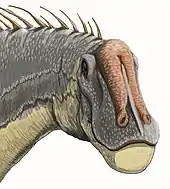Dicraeosaurus
Dicraeosaurus (Gr. δικραιος, dikraios "bifurcated, double-headed" + Gr. σαυρος, sauros "lizard") is a genus of diplodocoid sauropod dinosaur that lived in what is now Lindi Region, Tanzania during the late Jurassic period. The genus was named for the neural spines on the back of its neck. The first fossil was described by paleontologist Werner Janensch in 1914.
| Dicraeosaurus | |
|---|---|
 | |
| Dicraeosaurus skeleton | |
| Scientific classification | |
| Domain: | Eukaryota |
| Kingdom: | Animalia |
| Phylum: | Chordata |
| Clade: | Dinosauria |
| Clade: | Saurischia |
| Clade: | †Sauropodomorpha |
| Clade: | †Sauropoda |
| Superfamily: | †Diplodocoidea |
| Family: | †Dicraeosauridae |
| Subfamily: | †Dicraeosaurinae Janensch, 1929 |
| Genus: | †Dicraeosaurus |
| Type species | |
| †Dicraeosaurus hansemanni | |
| Species | |
| |
Description

Unlike most diplodocoids, Dicraeosaurus had a comparatively large head with a relatively short and wide neck. The neck contained 12 unusually short vertebrae, likely indicating a low-level browser of vegetation no more than 3 metres (9.8 ft) off the ground.[1] Dicraeosaurus also lacked the "whiplash" tail tip typical of diplodocoids. It was smaller than many other diplodocoids, at only 14–15 metres (46–49 ft) in length and 5–6 metric tons (5.5–6.6 short tons), though this still makes it among the larger known members of the family Dicraeosauridae.[2] The genus is notable for the rather tall neural spines protruding from its vertebrae, which it is named for. They were not straight as in some members of the family, instead forming a rough "Y" shape. These spines likely provided muscle attachment points.[3]
Palaeoecology

Dicraeosaurus was a mid-sized herbivore for its ecosystem, found in the Tendaguru Formation of Tanzania, which dates to the Late Jurassic. The rocks also yield fossils of Giraffatitan and Kentrosaurus. As there was a distinct difference in size between these dinosaurs, they would probably have browsed on vegetation at different levels and therefore competition between them was likely rare.[3]
References
- Benton, Michael J. (2012). Prehistoric Life. Edinburgh, Scotland: Dorling Kindersley. p. 270. ISBN 978-0-7566-9910-9.
- Paul, Gregory S. (2016). The Princeton Field Guide to Dinosaurs. Princeton University Press. p. 210. ISBN 978-1-78684-190-2. OCLC 985402380.
- Palmer, D., ed. (1999). The Marshall Illustrated Encyclopedia of Dinosaurs and Prehistoric Animals. London: Marshall Editions. p. 132. ISBN 1-84028-152-9.










